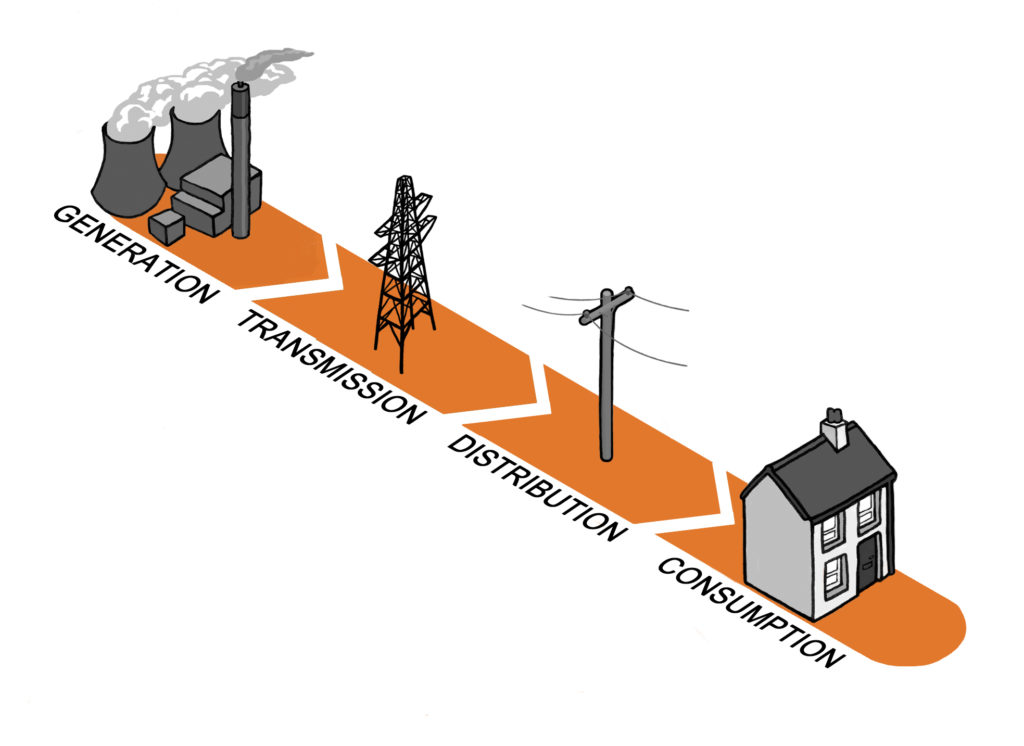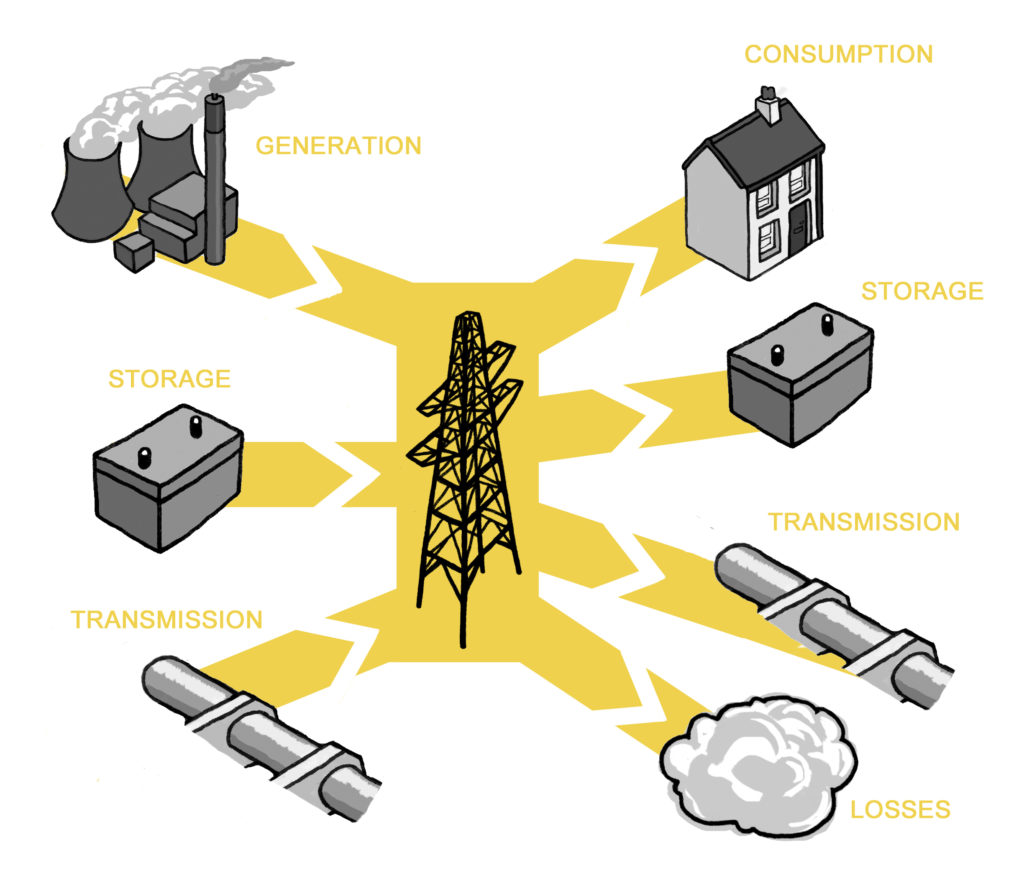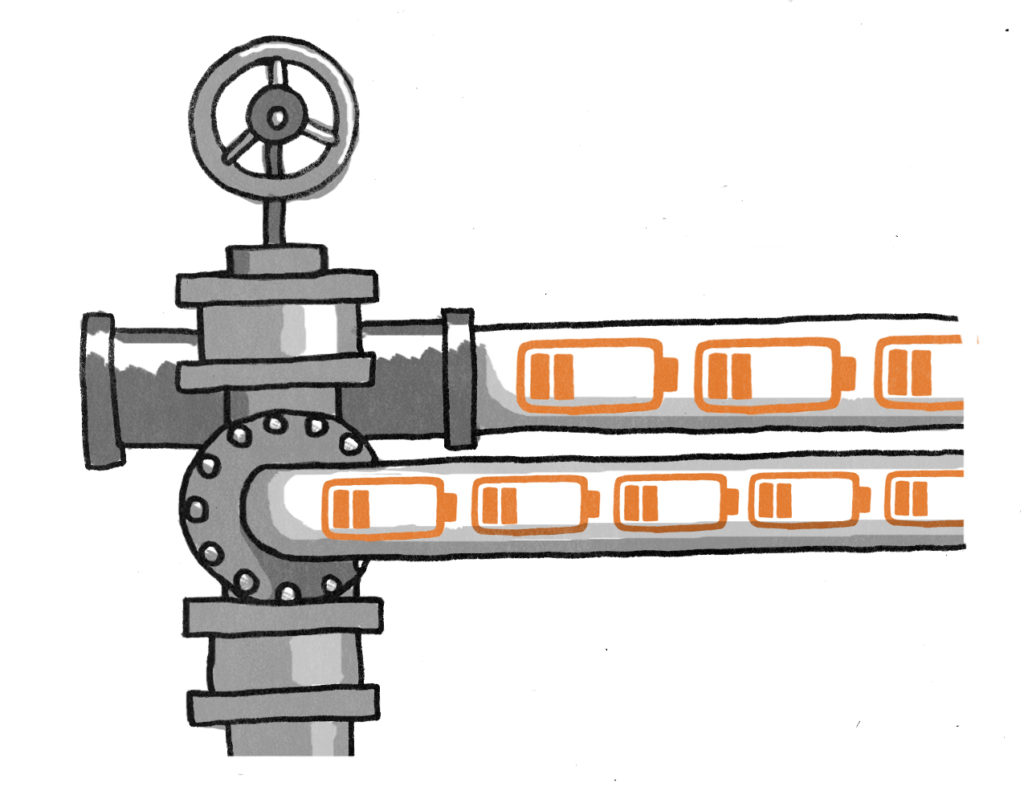QUESTIONS FOR ENERGY DEMOCRACY: What physical energy infrastructure do we already have in GB? How does it work? How is it changing? What are the benefits and problems of our legacy infrastructure, as we integrate new technologies? What changes and what use of our historic legacy would be most beneficial for energy democracy?
The GB energy system in the 20th century was based on centralised, fossil-fuel based electricity and gas networks. In the 21st century, there is a need to shift from fossil fuels to renewable energy, which involves decentralisation and an opportunity to democratise the system.
Energy infrastructure includes ways that we:
- capture energy and turn it into a form we can use
- transport it
- store it
- use it
- measure and monitor the system
As discussed in the section on the physics of energy, we use and transport energy in many different forms. The existing national grids in GB serve electricity and gas with pylons and pipes which cross the whole country. However, other forms of energy infrastructure, such as heat networks, could become increasingly important in future.
Historically, energy has primarily been stored in the form of fossil fuels – coal or natural gas in the ground or stockpiled. A low carbon energy system needs other forms of storage. The relationship between different types of energy system is also becoming more complex. For example, we might store electricity as hydrogen gas, or store heat rather than electricity, and at different times it may be more efficient to use energy from electricity or from gas.
This chapter is split into three sections. Click on the link for more detailed information.
- Energy capture infrastructure: Where do we get energy from, and how?
- Energy storage and transportation infrastructure: How do we get energy from where it is available when it is available to where it is needed when it is needed?
- Energy consumption infrastructure: How do we use energy, for what, in what form, and when?
Electricity Infrastructure Overview
There are particularly big changes emerging in the configuration of electricity infrastructure. An overview of these is shown in the images below, to help orient you through the coming detailed chapters.

Core components
Generation: generation of electricity from primary energy – coal, gas, wind
Transmision: high voltage network of cables and pylons, mainly takes electricity from power stations to towns and cities. Some large industrial users are connected to the transmission network.
Distribution: medium and low voltage regional network of cables and pylons, taking electricity from transmission network to industry, homes and commercal buildings. Electricity is gradually stepped down from high to low voltages in transformers and substations
Consumption: final use of electricity by consumers. The amount needed for a particular activity depends on energy efficiency and practices of energy use.
The UK electricity system has already begun to shift from this basic layout, as renewable energy technologies have been installed. These changes cause some technical challenges, but can be largely absorbed into the existing network.

Additional components
Remote renewable generation: energy generation in different locations to the existing thermal power stations, e.g. offshore wind, marine technologies, rural solar and wind farms.
Additional transmission: Some renewable energy needs new high voltage transmission cables to be built. This can be with pylons or underground cables.
Distributed generation: smaller scale renewable generation can connect directly to the existing distribution network. However, there is a limit to how much can be absorbed without disrupting voltages or causing overheating.
Building-based generation: Some renewable energy, e.g. solar PV panels on buildings, are installed “behind the meter”. This can also cause technical challenges for the distribution network.
Many forms of renewable energy are initially captured as electricity (e.g. solar and wind power). A sustainable energy future that switches to electricity for transport and heating will pose big challenges for electricity transmission and distribution.
Such a shift would significantly increase electricity consumption (see section on consumption), which could cause stress on the network. Building based electricity generation (e.g. solar panels) is importing electricity at a different place in the system, creating more complex energy flows. At the same time, new digital and information technology, including smart meters and active control systems help handle this complexity and additional load, providing information that wasn’t previously available and allowing the timing of different parts of the system to be controlled.

New components
Storage: storing electricity when genereation is plentiful for use when it is scarce, for example in batteries.
Electric Vehicles (EVs): using renewable electricity instead of petrol or diesel to power cars. This is A LOT of energy, so has a big impact on the network. The batteries in electric vehicles (EVs) can also act as storage.
Smart Meters: meters which record electricity consumption every minute, and can interact with an in home display, or remotely switch appliances to optimise when they are used.
More efficient consumption: The amount of electricity consumed can be reduced by switching to more efficient appliances and lights, or by using less. There are also opposing trends towards using more.
Electric heating: most of our heating is done by gas or oil, and switching to electric heating, particularly heat pumps, could be a good way of moving away from fossil fuels, assuming that electricity is renewable.
Timing
The time dimension of electricity use is particularly important. The amount of electrical power being taken from the transmission and distribution networks at each moment must be exactly the same as is supplied. In the gas network, variation in pressure in the pipes is acceptable and can act as a buffer for very short term differences in supply and demand.This is not possible in the electricity system. If electrical generation and consumption go out of balance, the voltage and frequency go outside of a tightly regulated band – a single frequency is needed across the whole network for all of the generators connected to it to work together effectively.
The power going into the network is all of the connected generation plus any electricity discharged from storage, or imported through interconnectors. The power being taken from the network is the electricity being consumed plus losses plus any energy being charged to storage or exported via interconnectors.

The live data on electricity being generated, and being imported/exported through interconnectors, is shown on website GridWatch.
With the exception of storage and interconnectors, total generation and consumption of electricity are equal at every moment. In the current system, dominated by thermal power stations, generation follows consumption, i.e. supply follows demand.
The time when electricity is needed (link to section in energy consumption infrastructure) and the time when electricity is available from intermittent renewable sources (link to section in Primary sources of energy) are not always matched. Fluctuations can be reduced by smoothing effects of having a national electricity network. However, remaining differences at a national scale call for some form of energy storage.
Flexibility
As we shift to renewable energy, new energy services are needed. At the same time, technological innovation is creating new possibilities. In particular, matching the time that we use electricity with the time that it is generated from renewable sources becomes increasingly valuable, as does storage.
The combination of renewable energy generation (which is not controllable), distributed generation (i.e. electricity entering the system at the ‘downstream’ end), the electrification of heat and transport energy (adding big and differently timed loads), and the availability of smart information and control technology, creates a need and a possibility for electricity system functions called ‘flexibility’, ‘demand side response’, or a ‘smart grid’. These terms refer to the increased need for complex temporal management of electricity, and all cover roughly the same collection of technological challenges and solutions. In this guide, they are discussed under the heading of flexibility.
Key components of flexibility include:
- Seeing what is happening in a system where flows of electricity have become too complex to predict by making calculations. Including
- Smart meters in homes [green]
- Smart metering at other points in the system e.g. substations [green]
- Control of the time of flow of electricity in and out of the system at particular locations. Using
- Remote switching of storage [blue]
- Remote switching of consumption appliances (automated) [blue]
- Voluntary changes in time patterns of electricity use by consumers (non-automated) [blue]
- Restructuring of incentives so that balancing actions become worthwhile. For example [blue]
- Time of use tariffs [blue]
- Payments for flexibility services [blue]
- Regulations and limits on instantaneous demands [blue]
The responsibility for ensuring that the electricity system is balanced currently lies with the System Operator (national grid). This is partially shifting to the Distribution System Operator (the local/regional network operator). Their leverage over time and location of generation, consumption and storage of electricity is limited, partly due to regulatory separation of functions as part of ‘unbundling’ to create competitive markets. They rely on price incentives and market mechanisms – i.e. indirect levers – to fulfil their responsibilities. This creates complex relationships with other parties, mediated through market mechanisms.
Providing flexibility by changing the time of use of appliances is really a question of electricity consumption infrastructure. This is why flexibility is often referred to as ‘demand side response’ – meaning changes that take place ‘behind the meter’.
This is discussed in more detail in the section on energy consumption infrastructure.
Gas Infrastructure Overview
The basic gas system configuration is shown below. It has a lot in common with the electricity system. Storage is included in this image, unlike the basic electricity system image, because it is inbuilt to the gas system in a way that it is not inbuilt to the electricity system.

Gas emerging trends
One pathway for the significant decarbonisation of the energy system could lead to the gas network becoming redundant. However, if all of the heat and other uses currently provided by gas were provided by electricity, the electricity grid would need very substantial upgrading. This would be enormously expensive and a significant infrastructure challenge. Additionally, perhaps partly because of this, UK government policy in 2015-2019 is supporting continued extraction from the North Sea, and onshore shale gas extraction (fracking, or hydraulic fracking). This is not low carbon, and has a low EROI (energy return on energy investment, see physics of energy).
Other alternative (and actually low carbon) ways of using the gas network include:
- injection of biomethane produced through anaerobic digestion of food waste, sewage, livestock slurry, or other organic wastes; [blue]
- injection of electrolysed hydrogen or synthetic methane produced from air and water using renewable electricity at times of surplus. [blue]

Hydrogen is a form of energy storage, rather than a source of primary energy (see physics of energy). However, hydrogen production and mixing with methane has substantial safety and operational challenges, as hydrogen is highly explosive. Additionally, many ways of producing hydrogen produce high quantities of CO2 as a by-product. This could be used with carbon capture and storage, in old oil and gas fields in the North Sea for example, and potentially as part of getting more oil and gas out. Extracting more fossil fuels would not be good for the climate!
Timing
While the electricity system needs to be ‘balanced’ at every moment, there can be differences in the rate of gas added to and taken from the gas network at any time. If the amount going in is higher than the amount going out, the pressure rises, and vice versa, and a certain amount of change in pressure is OK. However, the pressure must remain within certain bounds.
As gas is the main fuel used for heating buildings in the UK, there are strong seasonal variations in consumption of gas, as discussed in Energy consumption infrastructure.
Heat Networks/district heating overview
Heat networks, also called ‘district heating’ are insulated pipes which carry a hot fluid, typically water, from a heat source such as a boiler to where heat is needed. They are particularly valuable when they make use of heat that would otherwise be wasted, such as waste heat from thermal power stations, which can be used at a lower temperature in homes. Heat networks can also be valuable in enabling easy updating of the heat source to a more low carbon or efficient source, because only one large central boiler needs to be changed rather than one in each house.
Heat networks have been used for a long time in former soviet and scandinavian countries, particularly denmark. They are relatively new in the UK, and are supported by the ‘heat networks development unit’ (HNDU). Policy support for district heating is based on the potential to serve the heat network using low or zero carbon sources of heat.
Photo islington council
In practice, many district heating networks still using natural gas, but the larger scale energy centre allows this to be ‘combined heat and power’, producing both electricity and heat, which is more valuable to the energy system as a whole than just heating. It is also likely to be easier to swap the technology in the energy centre for something lower carbon such as a heat pump or hydrogen boiler, or biomass boiler, than making these changes on a house by house basis.
LEARNING POINTS FOR ENERGY DEMOCRACY:
- Existing energy infrastructure, particularly electricity cables and gas pipes, was developed for a centralised, one-way flow of energy from big power stations to users. One way of looking at this is ‘if I wanted to design a zero carbon energy system, I wouldn’t start here’.
- On the other hand, our existing energy infrastructure is pretty useful, especially for balancing out the moments when it’s windy in one part of the country and not another. It also helps balance out the different moments that different people use energy. Let’s not throw the baby out with the bathwater.
- Different forms of energy – gas, electricity, heat – will play interdependent roles. Fossil gas is not a good option, but it may be good to use biogas and hydrogen in those pipes instead of building a hugely reinforced electricity network.
Next: energy caputure infrastructure or skip to energy and land